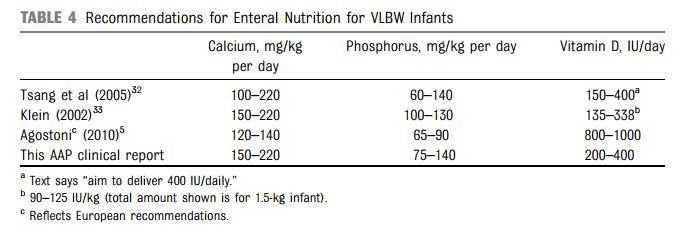Preemies have increased need for vitamin D and Calcium (Rickets)
Calcium and vitamin d requirements of enterally fed preterm infants.
Pediatrics. 2013 May;131(5):e1676-83. doi: 10.1542/peds.2013-0420. Epub 2013 Apr 29.
Abrams SA; Committee on Nutrition; Collaborators (6)
Bone health is a critical concern in managing preterm infants. Key nutrients of importance are calcium, vitamin D, and phosphorus. Although human milk is critical for the health of preterm infants, it is low in these nutrients relative to the needs of the infants during growth. Strategies should be in place to fortify human milk for preterm infants with birth weight <1800 to 2000 g and to ensure adequate mineral intake during hospitalization and after hospital discharge. Biochemical monitoring of very low birth weight infants should be performed during their hospitalization. Vitamin D should be provided at 200 to 400 IU/day both during hospitalization and after discharge from the hospital. Infants with radiologic evidence of rickets should have efforts made to maximize calcium and phosphorus intake by using available commercial products and, if needed, direct supplementation with these minerals.
PMID: 23629620
TABLE 1 High-Risk Criteria for Rickets in Preterm Infants
Born at <27 weeks' gestation Birth weight <1000 g
Long-term parenteral nutrition (eg, >4 to 5 weeks)
Severe bronchopulmonary dysplasia with use of loop diuretics (eg, furosemide) and fluid restriction
Long-term steroid use
History of necrotizing enterocolitis
Failure to tolerate formulas or human milk fortifiers with high mineral content
Disagreement as to how much vitamin D is needed: 150 IU or 1000 IU

PDF is attached at the bottom of this page
See also Vitamin D Life
Calcium reduced some rickets in Nigerian children – Feb 2012
More Calcium absorbed from formula than breast milk, lacking vitamin D – Aug 2012
Very short children were very low on vitamin D and Calcium – Aug 2010 stunting?
Many preemies need at least 800 IU of vitamin D – RCT May 2013
Why higher levels of vitamin D reduces premature birth - April 2011
Premature delivery associated with low vitamin D in Japanese women – Mar 2011
Infant-Child category starts with
{include}
See also web
- Vitamin D Council summary of the publication
- For babies that weigh less than 1500 g (3.3 lbs), they should get biochemical testing for bone mineral status starting 4 to 5 weeks after birth. Babies that weigh over 1500 g do not necessarily need this testing.
- If the babies’ serum alkaline phosphatase activity is greater than 800 IU/L to 1000 IU/L or the baby is getting fractures, they should receive radiographic evaluation for rickets and treated with calcium and phosphorus as necessary.
- Preterm infants weighing less than 1800 to 2000 g (4.4 lbs) should receive human milk fortified with minerals or take formula specifically designed for preterm infants.
- For preterm and very low birth weight infants that weigh less than 1500 g, they should get 200 to 400 IU of vitamin D/day.
- For infants that weigh over 1500 g, they should get 400 IU/day. The maximum preterm and very low birth weight infants can get is 1000 IU/day.
- When infants reach a body weight of greater than 1500 g, vitamin D intake should be around 400 IU. The maximum they can get is 1000 IU/day.
- Infants with cholestasis, other malabsorptive disorders, or renal disease should be considered for special assessment, sometimes warranting 25(OH)D levels over 50 ng/ml.
